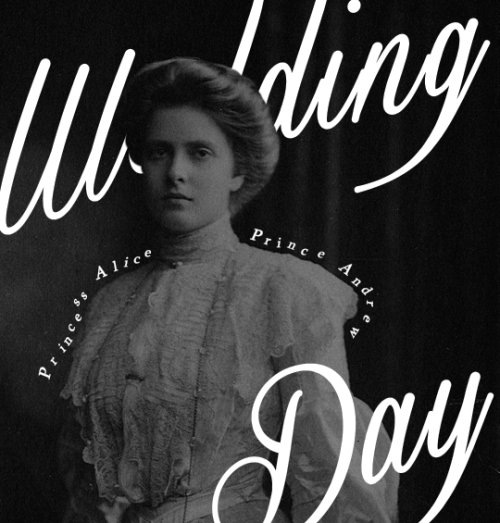#princess alice of battenberg
HISTORICAL ANECDOTE → Princess Alice of Battenberg & Prince Andrew of Greece wedding day.
One of the largest influxes of royalty for many years descended on Darmstadt for the wedding. The carriage came out, the royal redisences were prepared and an air of excitement permeated the normally sleepy city.
On the morning of 6 October the civil marriage took place, with only near relations attending. Next day there were then two religious ceremonies.First Alice and Andrea were married by Protestant rite in the chapel in the Alte Schloss, and then they went to the new Russian chapel on the Mathildenhöhe. For the occasion the Battenbergs produced the old state carriage of Prince Alexander of Hesse to convey the bride to church. The groom wore his Red Dragoons uniform, and the riband and star of the Grand Cross of the Royal Victorian Order, given him by Edward VII. Alice wore a beautiful lace dress with a veil of myrtle and orange blossoms. The bridal procession was greeted with a wedding song composed by William de Haan with words from the book of Ruth, sung by the choir of the Court Theatre. The royal guests then formed a semi-circle around the bridal pair for the ceremony itself. At this service Alice misheard the questions, and said “no” instead of “yes” when asked if she assented freely to marriage, and “yes” instead of “no” when asked about having promised her hand elsewhere.
The Russian service was more exotic and more intimate, with the rites said by a high priest and an archimandrite. Alice’s aunt Marie Erbach recalled : “We were received by Russian and Greeks, blazing with gold, and led into the rich, beautiful chapel, where we were greeted by three priests in golden vestments. The bridal couple, who, of course, came last, stood on a carpet of rose-coloured silk - a symbol of the path of life.” Four princes held the heavy wedding crowns of Catherine the Great over the heads of the young couple, “who held candles in their hands. The circling of the altar three times, during which the crowns were held over their heads, was a little difficult. After the concluding Te Deum, Andrew led his wife to the parents on both sides.”
After the ceremonies, there was a large family dinner, with no suites in attendance. The departure was the opportunity for merry high jinks amongst the royal guests. Shoes were tied to the back of the carriage. When they set off, rice and slippers were thrown at them. Ernie and the Tsar were to the fore, rushing after them into the crowd, hotly pursued by excited policmen and plein-clothes Russian detectives, clutching umbrellas. Mark Kerr told the tale:
The Emperor went straight for the backs of the people, who were anxiously awaiting the passing of the Royal carriage. Putting his head down, he ramned them and gradually pushed his way through the six files of human beings, shedding the children from his coat-tails on the way, and reached the street at the moment when the carriage was going by with Princess Alice bowing her acknowledgments to the cheering crowd. At this moment she received the full bag of rice, which the Emperor had carried, in her face, followed by the satin shoe. Casting dignity aside she caught the shoe, and leaning over the back of the carriage hit the Emperor on the head with it, at the same time telling him exactly what she thought of him, which so over-came him that he stood still in the middle of the road shrieking with laughter.
After this the bride and groom transferred into their new Wolseley car, a gift from the Tsar in a soberer moment before he began to enjoy the wedding, and departed for the Heiligenberg.
Alice Princess Andrew of Greece by Hugo Vickers
Post link



